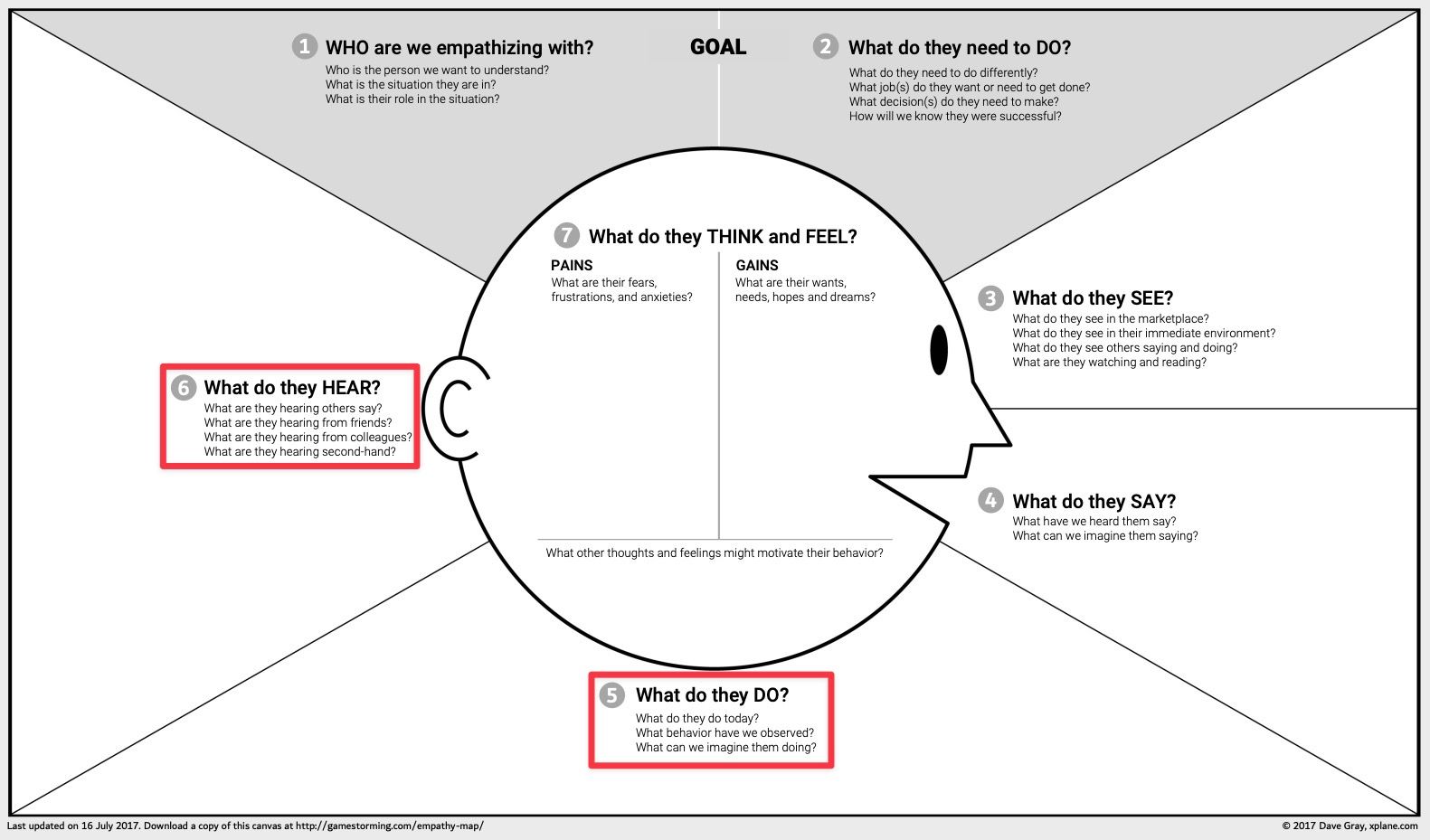Hey friend,
Yesterday’s lesson ended with what our persona says. Today, we sharpen our picture of them by looking at what they do and hear.
What people say and what they do doesn’t always align. That’s one reason user interviews are only partially useful. But weirdly enough, people tend to be more honest when posting anonymously online.
In this lesson, we’ll learn all about parts five and six of the Empathy Map Canvas:

It might have seemed more logical to discuss see and hear at the same time, and that’s what most empathy map canvasses do. But I like the sequence Dave Gray recommends, so I stick to it. In a bit, we’ll see why this order makes sense.
But first, let’s dig into what our persona does:
What does your persona do?
Look at yourself: how are your New Year’s Resolutions going?
It’s easier to publicly announce something than to show up every day when nobody is looking. That’s why people who are serious about their goals get accountability partners and hire coaches. But there are tons of other ways people (try to) stick to their goals, which is what this part of the empathy map is about.
Dig into your Sales Safari research and journal about these questions:
What do they do today?
On Tuesday, we looked at our persona’s goal (what they want to be able to do in the future), but they all start where they are now. So, search your Sales Safari notes for whatever your persona says about what they’re doing right now to (try to) tackle their challenges.
What behavior have we observed?
Remember that I told you to see if people ask the same question over and over? In their repeated cries for help, you can observe some of the behavior of your persona. For example, are they likely to abandon what they try out, or do they ignore advice completely?
What can we imagine them doing?
Does your persona stick to their word, or are they likely to abandon their plans? Knowing this will help you better help your persona, as you can undercut their self-sabotaging behavior when you’re aware of it.
What does your persona hear?
Like it or not, your audience is more likely to listen to their friends and family than to any expert. That’s because they can look those people in the eye and hear their voices, while you will be a few pixels on the screen at most.
To me, there’s a real difference between the see and the hear parts of the empathy map. At the risk of becoming philosophical, hearing in this context seems much more profound than seeing.
When we read (see) something online, it can affect us, but it’s unlikely to change our lives. But when we have a face-to-face conversation with people we know and trust, their words will make much more of an impact.
Besides, don't we hear feedback from the people around us when we do something new?
We need to be aware of who our persona is lending their ear, so ask yourself:
What are they hearing from friends?
Friends (and family) are our biggest influence — which means it’s also that of our persona. We can see all we want online, but if a friend makes fun of something (or promotes it) in real life, that will have a bigger impact.
What are they hearing from colleagues?
If your persona works full-time, they spend by far the most time with their colleagues. Especially when their co-workers are perceived as experts, your persona is much more likely to listen to them than you.
What are they hearing second-hand?
Even if their friends or colleagues aren’t experts themselves, they’ll have heard of other experts. When it’s between second-hand advice from someone online or in real life, the person whose voice you can hear (literally) will have much more authority than some text from an internet stranger.
The goal of all these questions is to become more aware of your persona’s world. They are also helpful for one-on-one interviews with people in your audience. With the answers they trigger, you can overcome objections in your marketing copy. But that’s something for another time…
Recap and what’s next
Before I leave you to study your notes and write about them, here’s a summary of the most important points from this lesson:
- Know what your persona does. Based on what you’ve been reading online from your persona so far, you likely have a sense of what your persona is already doing to tackle their challenges (even if they fail).
- Find out if what they say and do align. The cliché is true: easier said than done. Do a bit of detective work to see if your persona keeps their promises or not. If not, there’s an opportunity to help them.
- Piggyback off their most important influences. We’re ending our journey through our persona’s world by considering who they’re listening to. Know which people have an outsized influence on them, and you’ll start to understand how to impact your persona.
While it’s impossible to know precisely what a group of people (i.e., a persona) thinks, walking through their outer world probably gives you a sense of their inner world (especially if you’ve been researching people like yourself).
So, that's what we'll do tomorrow when we finish the empathy map by considering our persona’s thoughts and feelings.
As always, I’d love to read your thoughts or suggestions. Drop a comment or reply to this email.
—Ramses




